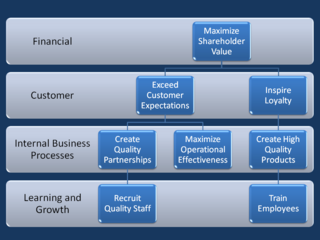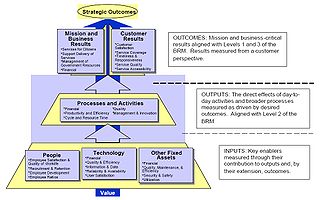Project management is the process of leading the work of a team to achieve all project goals within the given constraints. This information is usually described in project documentation, created at the beginning of the development process. The primary constraints are scope, time, and budget. The secondary challenge is to optimize the allocation of necessary inputs and apply them to meet pre-defined objectives.
Strategic planning is an organization's process of defining its strategy or direction, and making decisions on allocating its resources to attain strategic goals.
Business performance management (BPM), also known as corporate performance management (CPM) and enterprise performance management (EPM),) is a set of performance management and analytic processes that enables the management of an organization's performance to achieve one or more pre-selected goals. Gartner retired the concept of "CPM" and reclassified it as "financial planning and analysis (FP&A)," and "financial close" to reflect two concepts: increased focus on planning and the emergence of a new category of solutions supporting the management of the financial close.
A balanced scorecard is a strategy performance management tool – a well structured report, that can be used by managers to keep track of the execution of activities by the staff within their control and to monitor the consequences arising from these actions.
Information technology (IT)governance is a subset discipline of corporate governance, focused on information technology (IT) and its performance and risk management. The interest in IT governance is due to the ongoing need within organizations to focus value creation efforts on an organization's strategic objectives and to better manage the performance of those responsible for creating this value in the best interest of all stakeholders. It has evolved from The Principles of Scientific Management, Total Quality Management and ISO 9001 Quality management system.

Organizational performance comprises the actual output or results of an organization as measured against its intended outputs . Organizational performance is also the success or fulfillment of organization at the end of program or projects as it is intended. According to Richard et al. (2009) organizational performance encompasses three specific areas of firm outcomes: (a) financial performance ; (b) product market performance ; and (c) shareholder return. The term Organizational effectiveness is broader.
Supplier relationship management (SRM) is the systematic, enterprise-wide assessment of suppliers’ strengths, performance and capabilities with respect to overall business strategy, determination of what activities to engage in with different suppliers, and planning and execution of all interactions with suppliers, in a coordinated fashion across the relationship life cycle, to maximize the value realized through those interactions. The focus of SRM is to develop two-way, mutually beneficial relationships with strategic supply partners to deliver greater levels of innovation and competitive advantage than could be achieved by operating independently or through a traditional, transaction purchasing arrangement. Underpinning disciplines which support effective SRM includes supplier information management, compliance, risk management and performance management.

A strategy map is a diagram that documents the strategic goals being pursued by an organization or management team. It is an element of the documentation associated with the Balanced Scorecard, and in particular is characteristic of the second generation of Balanced Scorecard designs that first appeared during the mid-1990s. The first diagrams of this type appeared in the early 1990s, and the idea of using this type of diagram to help document Balanced Scorecard was discussed in a paper by Robert S. Kaplan and David P. Norton in 1996.

In business computer information systems, a dashboard is a type of graphical user interface which often provides at-a-glance views of key performance indicators (KPIs) relevant to a particular objective or business process. In other usage, "dashboard" is another name for "progress report" or "report" and considered a form of data visualization. In providing this overview, business owners can save time and improve their decision making by utilizing dashboards.

Performance measurement is the process of collecting, analyzing and/or reporting information regarding the performance of an individual, group, organization, system or component.

Internal auditing is an independent, objective assurance and consulting activity designed to add value and improve an organization's operations. It helps an organization accomplish its objectives by bringing a systematic, disciplined approach to evaluate and improve the effectiveness of risk management, control and governance processes. Internal auditing might achieve this goal by providing insight and recommendations based on analyses and assessments of data and business processes. With commitment to integrity and accountability, internal auditing provides value to governing bodies and senior management as an objective source of independent advice. Professionals called internal auditors are employed by organizations to perform the internal auditing activity.
Internal control, as defined by accounting and auditing, is a process for assuring of an organization's objectives in operational effectiveness and efficiency, reliable financial reporting, and compliance with laws, regulations and policies. A broad concept, internal control involves everything that controls risks to an organization.
BSC SWOT, or the Balanced Scorecard SWOT analysis, was first introduced, in 2001, by Lennart Norberg and Terry Brown.

Sustainability accounting was originated about 20 years ago and is considered a subcategory of financial accounting that focuses on the disclosure of non-financial information about a firm's performance to external stakeholders, such as capital holders, creditors, and other authorities. Sustainability accounting represents the activities that have a direct impact on society, environment, and economic performance of an organisation. Sustainability accounting in managerial accounting contrasts with financial accounting in that managerial accounting is used for internal decision making and the creation of new policies that will have an effect on the organisation's performance at economic, ecological, and social level. Sustainability accounting is often used to generate value creation within an organisation.
Strategy implementation is the activities within a workplace or organisation designed to manage the activities associated with the delivery of a strategic plan.
Team service management (TSM) is an open-source management framework that uses and integrates existing management methods and techniques to help teams deliver ever improving services. TSM is designed to be used by any and all teams within an enterprise including sales, production, administration, IT, finance and management teams.
Enterprise performance management (EPM) is a field of business performance management which considers the visibility of operations in a closed-loop model across all facets of the enterprise. Specific to financial activities in the office of the chief financial officer, EPM also supports financial planning and analysis (FP&A). Corporate performance management (CPM) is a synonym for enterprise performance management. Gartner has officially retired the concept of CPM and reclassified into "financial planning and analysis (FP&A)" and "financial close" to reflect two significant trends – increased focus on planning, and the emergence of a new category of solutions supporting the management of the financial close.
Benefits Realization Management (BRM) is one of the many ways of managing how time and resources are invested into making desirable changes.
Results-based management (RBM) is a tool for monitoring and managing the implementation of strategy. It in many respects is similar to the logical framework approach, a strategy implementation tool used extensively by Non-governmental organizations.
Strategic control is the process used by organizations to control the formation and execution of strategic plans; it is a specialised form of management control, and differs from other forms of management control in respects of its need to handle uncertainty and ambiguity at various points in the control process.





